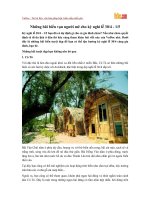4 1 5 the amazing geography of the west
Bạn đang xem bản rút gọn của tài liệu. Xem và tải ngay bản đầy đủ của tài liệu tại đây (4.45 MB, 12 trang )
Suggested levels for Guided Reading, DRA,™
Lexile,® and Reading Recovery™ are provided
in the Pearson Scott Foresman Leveling Guide.
Genre
Expository
nonfiction
Comprehension
Skills and Strategy
• Main Idea and
Details
• Graphic Sources
• Graphic Organizer
Life Science
Earth Science
Text Features
•
•
•
•
Map
Captions
Labels
Glossary
Scott Foresman Reading Street 4.1.5
ISBN 0-328-13425-2
ì<(sk$m)=bdecfa< +^-Ä-U-Ä-U
by Vana Dougias
Reader Response
1. Using a chart similar to the one below, what do
you think is a main idea presented in this book?
Give details to support the main idea.
Main Idea
2. Look at the map on page 13. What geographical
wonders can be found in California?
3. Use the word naturalist in a sentence to show its
meaning.
4. What word on page 3 has the same –ive suffix as
the word massive? Use the Glossary to find the
word’s meaning.
by Vana Dougias
Editorial Offices: Glenview, Illinois • Parsippany, New Jersey • New York, New York
Sales Offices: Needham, Massachusetts • Duluth, Georgia • Glenview, Illinois
Coppell, Texas • Ontario, California • Mesa, Arizona
The western United States has a lot to offer to
someone looking for adventure. If you have ever
visited California, Washington, or other western
states, then you may have seen some of the most
impressive sights and spots anywhere. Mount
Rainier, shown below, is just one of these. When
you travel out West, you will find some of the
highest mountains and the lowest valleys in the
United States. You will also see some of the most
beautiful, ancient geographical wonders in the
world.
Mount Rainier is one of our
beautiful natural resources.
Every effort has been made to secure permission and provide appropriate credit for
photographic material. The publisher deeply regrets any omission and pledges to
correct errors called to its attention in subsequent editions.
Unless otherwise acknowledged, all photographs are the property of Scott Foresman,
a division of Pearson Education.
Photo locators denoted as follows: Top (T), Center (C), Bottom (B), Left (L), Right (R),
Background (Bkgd)
Opener: Digital Vision; 1 Getty Images; 3 Getty Images; 4 Getty Images; 5 Corbis
Royalty Free; 6 Getty Images, Corbis Royalty Free, Medio Images; 7 Corbis Royalty Free;
8 ©DK Images, Getty Images; 9 Getty Images; 10 Creative Eye/Mira; 11 ImageState,
National Geographic; 12 Brand X Pictures; 13 Getty Images; 14 Brand X Pictures;
15 Brand X Pictures; 16 Brand X Pictures; 17 Brand X Pictures; 18 Brand X Pictures
ISBN: 0-328-13425-2
Copyright © Pearson Education, Inc.
All Rights Reserved. Printed in the United States of America. This publication is
protected by Copyright, and permission should be obtained from the publisher
prior to any prohibited reproduction, storage in a retrieval system, or transmission
in any form by any means, electronic, mechanical, photocopying, recording, or
likewise. For information regarding permission(s), write to: Permissions Department,
Scott Foresman, 1900 East Lake Avenue, Glenview, Illinois 60025.
2 3 4 5 6 7 8 9 10 V0G1 14 13 12 11 10 09 08 07 06 05
3
One of the best ways to explore the amazing
land forms of the western United States is to visit
a national park. National parks are areas that
have been set aside. They preserve the natural
landforms and protect the precious wildlife
found there.
In 1872 Yellowstone National Park became
the world’s first national park. It covers parts
of Wyoming, Idaho, and Montana. Eighteen
years later, in 1890, Yosemite National Park was
established in California. Soon, many other parks
were created in the United States.
Waterfall (left) and gold mine
site (right) at Yellowstone
National Park in Wyoming
4
There is a lot to learn about our nation’s
national parks. Yellowstone covers more
than two million acres. It’s no mystery where
Yellowstone got its name. Much of the rock there
is yellowish sandstone.
Yellowstone is famous for its geysers, such
as the one called Old Faithful. Geysers happen
when water is heated by volcanic material under
Earth’s surface. Sometimes the water gets so hot
that steam pressure is created. This causes the
heated water to gush up out of the ground.
Old Faithful is the
most famous geyser in
Yellowstone. It got its
name because of its
predictable eruptions.
5
Yellowstone is home to forests, rivers,
mountains, a canyon, and many kinds of
wildlife. Many different animal species live in
Yellowstone. Among them are grizzly bears,
bison, moose, and elk. In fact, Yellowstone
protects a large ecosystem, or environment, that
includes animals such as coyotes, wolverines,
and mountain lions. Park safety officials warn
guests to keep a safe distance as they watch the
wildlife, because wild animals can be dangerous.
Yellowstone National Park
during the spring
Elk
In addition to Yellowstone, there are many
other places in the western United States that
are unique. There are several mountain ranges
in the western part of the country. The Rocky
Mountains stretch all the way from Mexico,
through the United States, and into Canada and
Alaska. They form the geographical boundary
between the midwestern and western regions
of the United States. Pikes Peak, one of the
mountains in the Colorado Rockies, is a popular
tourist attraction. It has an interesting history.
Life in the Rocky
Mountains
Mountain goats
Coyote
Lime swallowtail
6
7
Pikes Peak is named for explorer Zebulon Pike.
He tried to climb the great mountain in 1806.
Pike and his fellow climbers were unsuccessful. A
snowstorm forced them to turn back. Since then,
many people have visited and climbed Pikes
Peak. Pikes Peak became an important landmark
for wagon trains heading west in search of
gold and land in the 1850s. In 1893, Katharine
Lee Bates, a teacher from Massachusetts, was
amazed by the view from the top of Pikes Peak.
It inspired her to write the lyrics to the song
“America the Beautiful.”
Ride up Pikes Peak in a car
or on the cog railway.
Pikes Peak is not the only famous mountain
in the western United States. The West is home
to some of the highest peaks in the world.
One of the most impressive is Mount Rainier in
Washington State. It is part of a mountain range
called the Cascades. Although it is covered in
layers of snow and ice, Mount Rainier is actually
a 14,410-foot volcano! Two million people visit
Mount Rainier each year. Some visitors like to
climb, hike, or ski its slopes. Others go to see the
beautiful wildflowers that grow in the meadows
near its base.
Mount Rainier
Zebulon Pike
8
9
Mount St. Helens is another volcano in the
Cascade Range. It is also located in Washington.
Mount Rainier and Mount St. Helens are part of
a group of volcanoes called the Pacific Ring of
Fire. These volcanoes got their name because
they are close to the Pacific Ocean and they form
the rough outline of a ring. Many volcanoes in
the ring are active. On the morning of May 18,
1980, Mount St. Helens erupted. An earthquake
triggered the eruption, which lasted nine hours.
The volcano released so much ash into the sky
that the day seemed to turn into night.
Before its eruption in 1980, Mount St. Helens
was known for its beautiful peak. After the
eruption, Mount St. Helens looked very different.
Although the mountain is still a beautiful sight,
it no longer has its famous peak. The earthquake
that caused the volcano to erupt also caused
the north side of the mountain to collapse and
slide down into the surrounding wilderness. An
avalanche of rock and ash covered much of the
forest and wildlife at the base of the mountain.
Mount St. Helens
Steam, lava, and ash
from Mount St. Helens
Clouds of ash from Mount St.
Helens in Yakima, Washington
10
11
California is an exciting state to visit, especially
for someone with an interest in land, rocks, and
nature. Many earthquakes have occurred along
the San Andreas Fault in California.
A fault is a fracture in Earth’s crust. These are
the areas where most earthquakes take place.
An earthquake is a sudden shaking of Earth’s
surface. Did you know that minor earthquakes
happen on Earth every day? Most quakes are
so minor that they cause no damage, but some
earthquakes are very dangerous.
There have been some major earthquakes
along the San Andreas Fault, shown below. Many
steps are taken to ensure the safety of people
who live near fault lines. Buildings are made with
special materials that help prevent damage if an
earthquake occurs. People who live in these areas
learn what to do to stay safe in an earthquake.
One of the most interesting places to visit
in California is Yosemite National Park. As we
learned earlier, Yosemite became a national park
in 1890. It was one of the first national parks
ever created in the world, and it remains one
of the most popular places for nature lovers to
visit. More than 3.5 million people visit Yosemite
every year.
Have you ever visited these places?
OREGON
IDAHO
San Andreas Fault
N E VA D A
Yosemite National Park
San Andreas Fault
Death Valley National Park
CALIFORNIA
Mojave National Preserve
ARIZONA
PA C I F I C O C E A N
12
13
Yosemite is a national treasure for many
reasons. The park is located in the Sierra Nevada
and offers many great views. A walk along
one of the park’s many trails may lead to cliffs,
waterfalls, streams, and meadows.
Someone who visits Yosemite will not want
to miss seeing the ancient giant sequoia trees
that live in its forests. Giant sequoias are the
world’s largest living things! Inside Yosemite, in
an area called Mariposa Grove, visitors can see
these giant sequoias. In this grove is a sequoia
called the Grizzly Giant. This tree is twenty-seven
hundred years old!
A sequoia pine cone and
bark from a sequoia tree
Another interesting place in California is
the world-famous Death Valley. Death Valley
is located just north of the Mojave Desert near
the border between California and Nevada. It is
one of the hottest places on Earth! During the
summer, temperatures often rise to 120˚F. Death
Valley is also the lowest point in the Western
Hemisphere. It is 282 feet below sea level.
Despite the heat and low altitude, is a beautiful
place filled with colorful rock formations, sand
dunes, and desert plants.
The best way to explore the exotic beauty
of Death Valley is to visit Death Valley National
Park. The park is a little bigger than Death Valley
itself. For people who like reptiles, this is the
place to go. Visitors might see a rare species, such
as the desert tortoise or the desert iguana.
A close look at cracked,
dry dirt from Death Valley
14
15
There is no doubt that California has many
fascinating places to visit, but Alaska and
Hawaii are also two of the most beautiful and
unusual parts of the United States. For someone
interested in becoming a naturalist, Alaska and
Hawaii are perfect places to begin nature studies.
Alaska is the largest U.S. state. It is home
to North America’s highest mountain. Mount
McKinley, 20,320 feet high, rises majestically in
Alaska’s Denali National Park and Preserve.
Mount McKinley is part of the Alaska Range,
a magnificent group of mountains and large
glaciers. The movement of each glacier helped
to form the dramatic landscape of Denali many
thousands of years ago.
Denali National Park is a nature and wildlife
refuge that covers more than six million acres of
land. Grizzly bears, wolves, and caribou are just
a few of the animals that live in Denali all year.
Many bird species also live in Denali during part
of the year.
Mountains and wildlife
Grizzly bear cub
16
Caribou
17
Hawaii is a state with an amazing story. The
state of Hawaii is made up of many islands.
The Hawaiian Islands were formed by erupting
volcanoes. The largest island is called Hawaii.
Two enormous volcanoes on the big island of
Hawaii are still active. Kilauea and Mauna Loa
add land to the island of Hawaii when lava oozes
out, slides down their slopes, and cools.
Mauna Loa is actually the biggest mountain
in the world! If you measure Mauna Loa’s height
from its base at the bottom of the sea to its very
top, it is about thirty thousand feet tall! That’s
about a thousand feet taller than Mount Everest.
The western United States is full of many
geographical wonders and wildlife preserves.
It is a great place to observe the habitats of
many plants and animals. Thousands of years
of volcanic eruptions, earthquakes, and the
movement of glaciers have made amazing land
formations. The beauty of the American West is
just one example of why conservation of nature
is so important. If we do not take care of the
natural world, we could lose all the wonderful
things that nature has to offer.
The Rocky Mountains
in Colorado
Lava rocks from Kilauea volcano
Steam rising from Kilauea
18
19
Glossary
glacier n. a great
mass of ice moving
very slowly down a
mountain, along a
valley, or over a land
area.
impressive adj. able to
have a strong effect on
the mind or feelings;
able to influence deeply.
naturalist n. person
who makes a study of
living things.
preserve v. to keep
from harm or change;
keep safe; protect.
20
Reader Response
slopes n. lines, surfaces,
land, etc., that goes up
or down at an angle.
species n. a set of
related living things
that all have certain
characteristics.
wilderness n. a wild
uncultivated region with
few or no people living
in it.
1. Using a chart similar to the one below, what do
you think is a main idea presented in this book?
Give details to support the main idea.
Main Idea
2. Look at the map on page 13. What geographical
wonders can be found in California?
3. Use the word naturalist in a sentence to show its
meaning.
4. What word on page 3 has the same –ive suffix as
the word massive? Use the Glossary to find the
word’s meaning.









